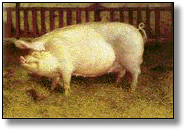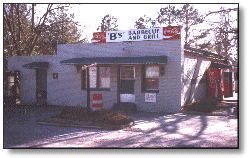

The United States Department of Agriculture says barbecue is any meat "cooked by the direct action of heat resulting from the burning of hardwood or the hot coals therefrom for a sufficient period to assume the usual characteristics" including the formation of a brown crust and a weight loss of at least thirty percent. Hmmm, that means Mother Nature made the first barbecue as the accidental by-product of some ancient forest fire. And, man has been eating the delicious stuff in one form or another to satisfy his carnivorous appetite ever since.
When the Spanish arrived in the Americas, they found the Taino Indians of the West Indies cooking meat and fish over a pit of coals on a framework of green wooden sticks. The Spanish spelling of the Indian name for that framework was "barbacoa". Both the name and method of cooking found their way to North America, where George Washington noted in his diary of 1769 that he "went up to Alexandria to a "barbicue."
Noah Webster's dictionary insists that the one and only correct spelling is barbecue. But, as another US president, Andrew Jackson, noted, "It's a damned poor mind that can think of only one way to spell a word ." He would be mighty pleased to know that over the years folks have been enjoying barbicue, barbique, barbeque, Bar-B-Que, Bar-B-Cue, Bar-B-Q, BBQ, Cue, and just plain Q. (Doesn't it just make you wonder how Dan Quail would spell it?)

The Hogs
The Spanish explorer DeSoto introduced hogs to Florida and Alabama about 1540. The settlers at Jamestown brought swine with them in 1607 and soon thereafter Virginia enacted a law making it illegal to discharge a firearm at a barbecue! The creatures thrived in the wilds of the warm Southern woodlands where cattle perished. By the time of the War Between the States, hogs had been domesticated, and pork had become the principal meat of the South. Not surprisingly, pork has been synonymous with Southern barbecue ever since.
The dictionary will also tell you that the noun "barbecue" has at least four meanings:
- a framework to hold meat over a fire for cooking
- any meat broiled or roasted on such a framework
- an entertainment, usually outdoor, at which such meat is prepared and eaten.
- a restaurant that makes a specialty of such meat.
Indeed, barbecues have long been a popular social occasion in the South. But, done in the traditional way, the making of barbecue was hard work. A pit was dug in the ground the day before the gathering and filled with hardwood. The wood was burned down to coals before whole hogs, skewered on poles, were hung over the pit. The pitmasters sat up through the night, turning the hogs on their spits. The following afternoon when the guests arrived, the crisp skin - Mr. Brown - was removed and the cooked meat - the divine Miss White - was pulled in lumps from the carcass before being slathered with a favorite finishing sauce. That's why, to this very day, a social affair centered around pork barbecue is affectionately called a Pig Pickin.
Some folks might consider barbecuing a whole hog to be a tad bit of overkill for a fellow with a sudden hankering for a sandwich. But, without benefit of electricity and refrigeration in bygone years, portioned cuts of fresh pork were nonexistent. A solution to this culinary dilemma was provided by a pair of entrepreneurs in Lexington, North Carolina when they hit upon the idea of barbecuing a couple of pigs over open pits in the town square on Saturdays and selling it. Tents soon popped up and the first commercial barbecue joint was born. The boys there in Lexington are still making some mighty fine barbecue in those barbecue joints. At last count, the city had one for every thousand citizens - men, women, and children included!

A good barbecue joint has a modest dining hall. In addition to plain tables, disposable paper place mats, and chairs with wooden seats, it will likely also have a counter with stool seats that swivel. A portrait of an elderly founder on the wall somewhere near the entrance is always a good sign. So are pictures, statues, and other sundry likenesses of pigs. A parking lot packed with a mixture of Harleys, pickup trucks, and Eldoradoes is an even better sign. The pits themselves are generally housed out back in a separate building to avoid burning down the joint in the event of a flameup. The building will have a screen door with a spring on it that twangs when the door slams shut. The hardwood in the yard nearby will be of various ages. You may not see smoke coming from the pit chimneys except when the wood is being burned to coals. But, you should always be able to smell it! Should you find copper lines leading to the pits from a silver tank the size of a small elephant out where the woodyard ought to be, drive on. You ain't there yet! The founder's son has sold his soul to the Devil for the ease of that modern-day bane of barbecue, propane. Come back in a couple of years and you will find a brand new McDonalds there with a drive-up window right where the pits once stood. Good barbecue is a hard way to make a buck.
There is no debate in North Carolina that barbecue should be
pit-cooked and pork. There is, however, is great disagreement
about which parts of the pigs should be barbecued and whether tomatoes should be any part of the finishing sauce. Down east, the whole
hog, split down the middle, is barbecued . The finishing sauce is
a sharp, tomato-free vinegar-and-pepper ketchup. West of U.S.
Highway 1, only the shoulders are barbecued, and the milder
finishing sauce contains a touch of tomato. Which is better? That most likely depends on which joint you happen to be in at the moment!